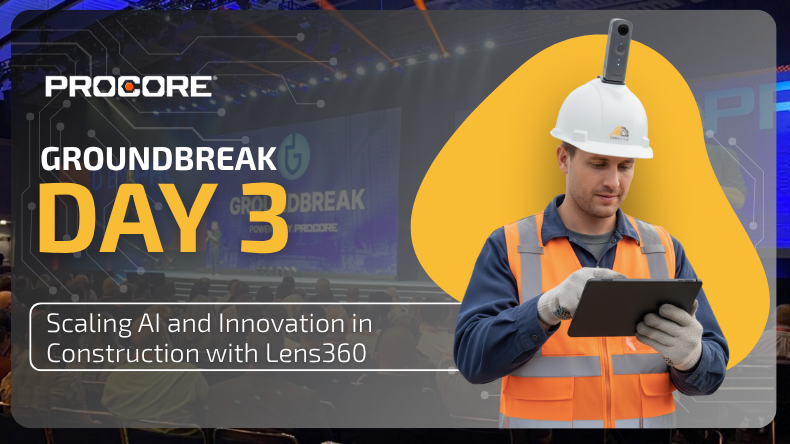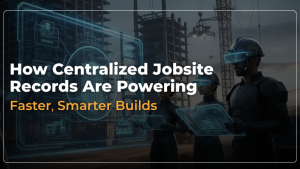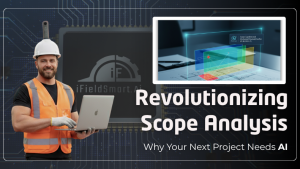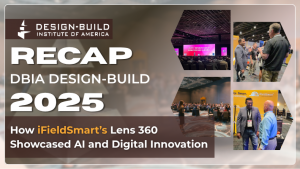Reading Time: 6 minutes
When Construction Meets the Future
Groundbreak 2025’s third day was not just about showcasing technology; it was also about demonstrating its functions best in the field, where it matters most.
At booth 1210, Lens360 by iFieldSmart.AI sparked conversations that cut deeper than demos. Superintendents, project managers, and trade contractors weren’t just curious; they were ready. Ready to scale AI, capture jobsites more intelligently, and integrate data without the usual friction.
The message was clear: construction isn’t cautiously adopting tech anymore. It’s actively demanding solutions that deliver right now, on real projects.
Work Smarter, Not Harder
iFieldSmart empowers your team with AI-driven efficiency to simplify scheduling, boost collaboration, and keep projects on track.
Schedule a MeetingWhat Day 3 Was Really About
The first two days of the event covered the basics of technology and project management. However, on Day 3, things were different as the participants went deeper into the practical application of their knowledge. The sessions centered on scaling AI across job sites, making data integration actually work, and turning VDC from a buzzword into a daily reality.
Here’s the thing. Every conversation we had at our booth circled back to the same challenge: how do you take all this technology and actually use it without adding hours to the workday?
That’s not a small question. That’s the question.
The AI Conversation:
Walk the floor on Day 3 and you’d hear AI mentioned everywhere. But here’s what changed from previous years: people weren’t asking if they should use AI. They were asking how to scale it.
That hit different.
What AI means for construction right now:
- Automated reporting and documentation with zero manual input
- Clash detection that catches problems before they become expensive
- Quality control that happens continuously, not just at inspections
- Project intelligence you can access by simply asking questions
The shift isn’t subtle. AI has moved from experimental to essential. The projects winning bids and finishing on time are the ones treating it that way.
360° Jobsite Capture:
Everyone at Groundbreak talks about capturing job sites. Day 3 revealed who actually delivers on that promise.
360° jobsite capture your entire site automatically, processing that data through AI, and giving you actionable insights. No manual uploads. No waiting for processing.
Here’s what a jobsite capture actually includes:
- Complete site documentation without disrupting workflows
- Automated AI-powered analysis of progress and deviations
- Visual proof linked directly to RFIs and submittals
- Time-stamped records that hold up in disputes
- Access from anywhere, any device, any time
Digital Twin Technology:
Digital twin became the most used phrase of Day 3. Everyone claims to build them. Few people explained what you actually do with one once you have it.
A digital twin isn’t just a pretty 3D model. It’s a representation of your project that updates as your site changes. It connects your plans, your reality, and your team’s decisions in one place.
VDC:
The VDC sessions on Day 3 drew attention. Virtual Design and Construction isn’t optional anymore.
Teams invest in VDC software, hire a coordinator, and wonder why adoption stays at 30%. The problem isn’t the technology. It’s the integration.
VDC works when:
- Field teams can access models without special training
- Design changes flow automatically to the people who need them
- Detect clashes in real time, not just at scheduled checkpoints.
- Constructability reviews include input from trades, not just engineers
- Everyone sees the same information at the same time
Data Integration:
But Day 3 proved that it serves as the foundation on which everything is based on data integration. Think about a workflow. You have RFIs in email threads, submittals in who knows where, specs in Procore, models in BIM 360, and pictures all over phones and cameras. Now consider attempting to respond to a straightforward query: how is the HVAC installation on Level 3 going?
You know the answer exists. But finding it takes calls, texts, emails, and probably a site visit.
Data integration solves this by:
- Connecting your existing tools without replacing them
- Linking visuals to RFIs, submittals, and observations
- Creating a single source of truth that everyone trusts
- Enabling AI chatbots that answer project questions instantly
- Building automated QA/QC workflows that catch issues early
What We Learned from the Conversations
Day 3 wasn’t just about technology demos. It was about understanding what’s actually holding projects back.
The patterns that emerged:
- Problem: Teams drown in documentation requirements, but never have the right documentation when they need it.
- Solution: 360 jobsite capture with an AI-powered organization that knows what you’ll need before you ask.
- Problem: VDC creates amazing models that field teams can’t or won’t use.
- Solution: AR walkthroughs and simple interfaces that make VDC accessible to everyone on site.
- Problem: Progress tracking consumes hours every week and still misses critical deviations.
- Solution: Lens 360 shows actual work completed and compares progress by date, trade, location, or scope.
Integration with Procore: Why It Matters
Procore dominated conversations on Day 3, which makes sense given the conference name. But the real insight wasn’t about Procore itself. It was about integration.
Teams don’t want to replace the tools that they have spent years learning. Teams want new features that enhance what they already use.
Lens360 works right with Procore, so you can see your 360° shots, AI info, and digital models all in one place. No duplicate data entry. Just better information where you need it.
True integration means your field team captures the site, and those observations automatically populate in Procore with linked visuals, timestamps, and AI-generated insights.
The Constructability Conversation That Changed Everything
The story we hear all too often..
A trade team spends weeks on installation only to discover that a coordination issue makes their work inaccessible or unusable in the next phase. The fix? A redesign, schedule delays, and costs that quickly climb into six figures.
The natural question follows:
“Could a better constructability review have caught this?”
The answer: Yes.
Modern constructability reviews go beyond static drawings. They bring the design to life before anyone installs a single pipe or wire.
- AI + Expert Reviews flag design gaps, missing dimensions, and cross-trade conflicts
- VR Walkthroughs allow trades to virtually experience the build sequence and spot access issues early
- 4D Digital Twins simulate real build logic, not just design intent
- Collaborative Planning Tools capture trade input before it’s too late
That’s why VDC and immersive design validation aren’t nice-to-haves anymore. They’re the difference between profit and painful lessons.
Looking Forward: What Day 3 Revealed About Construction’s Future
As Day 3 wrapped up, a pattern became clear. The construction industry isn’t slowly warming up to technology. It’s sprinting toward it.
The projects succeeding right now share these traits:
- They treat data as an asset, not a byproduct
- They use AI for actual work, not just marketing
- They integrate tools instead of accumulating them
- They make technology accessible to field teams, not just office staff
- They measure success by time saved and problems prevented, not features enabled
That’s the shift. Technology moved from impressive to essential. The question isn’t whether to adopt these tools. It’s how quickly you can scale them across your projects.
Join the Conversation
Groundbreak 2025 proved something important. The construction industry is ready for this transformation. The technology works. Researchers have proven the case studies. The time is now.
If you missed Day 3 or want to dive deeper into how these technologies work on your projects, visit iFieldSmart.com for more information.
The future of construction isn’t coming. It’s here. The only question is whether you’re ready to build it.








